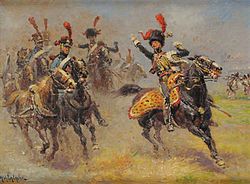| Imperial Guard Artillery | |
|---|---|
 Imperial Guard horse artillery taking up position, by Alphonse Lalauze. On the right, an officer in full "hussard" regalia, on the left, postilions of the train. | |
| Active | 1806-1815 |
| Country | France |
| Allegiance | First French Empire |
| Branch | Imperial Guard (Napoleon I) |
| Type | Horse regiment, Foot regiment, Artillery train |
| Role | Artillery |
| Engagements | Napoleonic Wars |
| Commanders | |
| Current commander | Jean Ambroise Baston de Lariboisière, Joseph Christophe Couin, Jean-Barthélemot Sorbier, Charles François Dulauloy, Jean-Jacques Desvaux de Saint-Maurice |
The Imperial Guard Artillery was made up of the organic units of the Imperial Guard of Napoleon I. It comprised a regiment of horse artillery, regiments of foot artillery and a train service responsible for supplying guns with powder and ammunition.
Contents
- Consular Guard
- The Imperial Guard
- Horse artillery
- Dismounted artillery
- Train
- Equipment
- Horse artillery 2
- Command
- Colonel general
- Colonel commanders and major commanders
- Battles and officer losses
- References
- Bibliography
- See also
From its creation until 1813, the Guard artillery was commanded by Marshal of the Empire, Édouard Mortier, Duke of Treviso, and from November 1813, by Marshal Louis-Gabriel Suchet, Duke d'Albuféra.



